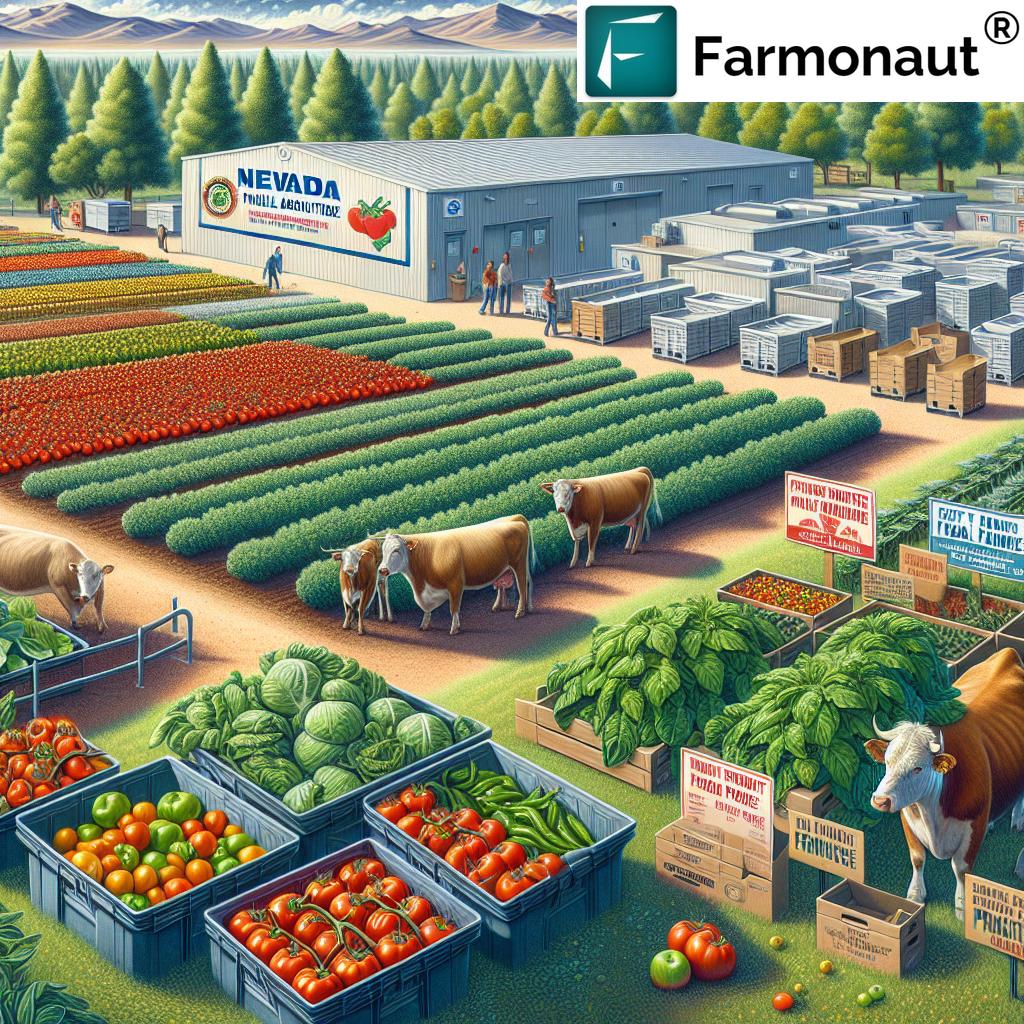Denio’s Farmers Market & Swap Meet: 2026 Prices, Local Sustainability, and Community Impact
“In 2025, over 8,600 farmers markets operate year-round in the U.S., boosting local economies and community food access.”
The Evolving Landscape of Farmers Markets in 2026
Denio’s Farmers Market & Swap Meet and similar farmers markets are not simply points for food sales—they are vibrant community hubs that foster direct connections between producers and consumers, supporting sustainable agriculture, local economies, and food security in the U.S. and beyond.
By 2026, the farmers market landscape continues to evolve in response to consumer values, climate considerations, and changing agricultural practices. Markets such as Denio’s Farmers Market, Union Farmers Market, Red Deer Farmers Market, and various Winter Farmers Markets exemplify this evolution, as they balance tradition and innovation to address food supply chain resilience.
Exploring Denio’s Farmers Market & Swap Meet: Traditions and Innovations
Denio’s Farmers Market & Swap Meet, located in a rural setting, stands as a central meeting point for exchange—not just of fresh produce but of artisanal goods, tools, seedlings, and other agricultural necessities. In 2026, it exemplifies how a traditional market is expanding beyond sales to become a multifunctional community event and an essential node in the local food chain.
Why Swap Meets Matter for Local Economies
- Swapping agricultural tools, feed, and inputs helps farmers minimize costs and reduce waste within their operations.
- The swap meet aspect encourages collaboration among local producers, strengthening regional networks.
- Denio’s attracts an average of 25,000 weekly visitors, providing an immense boost to the surrounding community’s economy.
This unique combination of a farmers market and swap meet ensures that local producers not only sell their goods but also access necessary items through barter or trade, optimizing resources and championing circular economy principles—a vital strategy as operational expenses rise in the agricultural sector.
“Swap meets like Denio’s attract up to 25,000 weekly visitors, strengthening regional food networks and sustainable agriculture.”
Benefits of the Denio’s Swap Meet Model
- Reduces input costs by enabling the exchange of items like livestock feed, tools, or seedlings.
- Minimizes waste as unused materials find new life in the hands of others.
- Promotes community support during economic or climatic challenges, central to regional food security.
- Seasonal events and activities foster family engagement and agro-tourism.
In essence, Denio’s Farmers Market & Swap Meet is a case study in how farmers markets can help rural communities weather both economic and environmental changes, positioning themselves as vital ecosystems in the evolving agricultural landscape of 2025, 2026, and beyond.
Union Farmers Market, Red Deer Farmers Market & Winter Farmers Market: Models of Regional Dynamism
The expansive farmer’s market landscape in North America thrives on regional diversity—no two markets are alike. Union Farmers Market, Red Deer Farmers Market, and Winter Farmers Markets each carve out a unique niche, catering to local consumer bases and growing conditions.
Union Farmers Market: Urban Agriculture at Its Best
- Situated in more urbanized areas, Union Farmers Market focuses on organic and specialty crops that cater to health-conscious urban consumers.
- Traceability and transparency are integral, with consumers eager to know the source of their food.
- Features a wide variety of seasonal and value-added products produced within close proximity, reducing the need for long supply chains.
Red Deer Farmers Market: Serving an Agriculturally Rich Region
- Red Deer Farmers Market flourishes in an agriculturally rich region, providing meat, dairy, grains, hardy root vegetables, and more.
- It is a platform for selling not only fresh produce but also processed and artisanal foods.
- Draws visitors interested in farm-to-table experiences and agro-tourism, generating new revenue streams for producers and surrounding businesses.
Winter Farmers Market: Extending the Season for Local Produce
Winter Farmers Markets operate throughout the colder months, leveraging advances in greenhouse technology, cold storage, and crop diversity. They have carved a unique niche by serving communities when supermarket food supply tends to rely on imports. These markets boost local food resilience and support sustainable consumption patterns by maintaining year-round access to high-quality, locally sourced products.
- Cold storage infrastructure enables fresh fruits and vegetables to be available even outside harvest season.
- Farmers employ innovative techniques to offer seasonal variety through the winter.
- Helps communities by reducing their dependency on long supply chains, a crucial factor amidst unpredictable global events.
Farmers Market Prices in 2026: Trends, Transparency, and Community Impact
Pricing dynamics remain a distinctive feature of farmers markets. Unlike large commercial chains, farmers market prices reflect the true costs of sustainable farming, including fair compensation for producers, environmental stewardship, labor, and supply chain resilience.
Key Factors Influencing Farmers Market Prices
- Seasonality: Prices adjust based on freshness, availability, and regional harvest calendars.
- Supply & Demand: Dynamic pricing allows vendors to adapt to weekly or even daily market shifts, avoiding waste and supporting profitability.
- Sustainability Practices: Organic and regenerative agriculture practices often lead to slightly higher, yet more transparent, pricing models—as consumers value the social and environmental benefits.
- Input & Operational Costs: As input costs rise (seeds, feed, tools), markets like Denio’s Swap Meet help reduce expenses through local exchange.
Dynamic market models are gaining traction, empowering farmers to optimize resources and maximize returns without compromising community affordability or fairness.
Estimated 2026 Prices and Community Impact of Denio’s Farmers Market & Swap Meet
| Product Category | Estimated 2026 Price (USD) | Seasonal Availability | Source (Local/Non-local) | Sustainability/Environmental Benefit |
|---|---|---|---|---|
| Fruits (Apples, Berries, Melons) | $2.50–$4.00/lb | Spring–Fall (Year-Round with storage/greenhouse) | Local | Supports local farms, reduces food miles |
| Vegetables (Leafy Greens, Root Crops) | $2.00–$3.50/lb | Year-Round | Local | Promotes diversified crops, sustainable soil use |
| Artisan Goods (Bread, Cheese, Preserves) | $5.00–$12.00/item | Year-Round | Local / Regional | Supports small producers, unique local flavors |
| Swap Items (Tools, Feed, Seedlings) | Barter/Trade Value ($10–$100 equivalent) | Year-Round, Peak During Pre-Planting | Local | Promotes reuse, resource optimization, reduces input costs |
| Meat, Dairy & Eggs | $7.00–$14.00/lb (meat); $4.00–$7.00/doz (eggs) | Year-Round (CSA/Winter shares available) | Local / Regional | Pasture-raised, lower transport emissions |
| Winter Offerings (Preserved, Pickled, Hydroponic) | $3.00–$6.00/item | Winter Months | Local/Regional | Extends supply chain, increases food security |
| Seedlings & Plants | $2.50–$7.00/plant or flat | Spring, Early Summer | Local | Encourages local gardening & biodiversity |
These estimated prices reflect current and projected trends for local goods and swap meet items at Denio’s Farmers Market & Swap Meet, emphasizing how such markets support sustainable farming, community exchange, and food system resilience in 2026.
How Farmonaut’s Satellite Technology Supports Sustainable Farmers Markets
At Farmonaut, we believe that transparent, real-time insights empower farmers and market organizers to make smarter decisions. Our satellite-based solutions deliver:
- Crop & Soil Monitoring: Access NDVI and multispectral data to assess vegetation health and optimize planting/harvesting cycles.
- AI-Based Advisory: Real-time, tailored recommendations for managing resources, reducing waste, and responding to weather events.
- Blockchain-Based Traceability: Guarantee product traceability from field to market shelf, building consumer trust and supporting transparency.
- Environmental Impact Tracking: Monitor and minimize carbon footprint, enabling sustainable agriculture practices that are essential for 2026 and beyond.
- Fleet & Resource Management: For large-scale supply and fleet management, streamline crop transport and market logistics, cutting operating expenses.
Our platform—accessible through  web and mobile apps—
web and mobile apps—
puts real-time agricultural intelligence at the fingertips of everyone in the farmers market supply chain, from rural producers to urban vendors and government food security officers.
For developers and agtech innovators, our API (Farmonaut API | API Developer Docs) enables seamless integration of satellite intelligence into custom software and market management tools.
For those on the go, our mobile applications for  Android and
Android and  iOS devices enable live updates, remote monitoring, and optimal farm management.
iOS devices enable live updates, remote monitoring, and optimal farm management.
Farmonaut‘s commitment is to help agricultural communities—like those at Denio’s Farmers Market & Swap Meet, Union Farmers Market, and Red Deer Farmers Market—navigate the challenges of 2026 and beyond with data-driven efficiency.
Learn how to scale up with our large-scale farm management solutions or optimize agroforestry/forest plantations via our crop, plantation & forestry advisory tools.
Affordable monthly or annual subscriptions are available for individuals, agribusinesses, and governments:
Infrastructure & Government Support: Strengthening Market Ecosystems
In 2026, governments and agricultural organizations increasingly recognize the role that farmers markets play in rural development, urban food access, and agricultural innovation. Targeted grants and infrastructure improvements are being deployed to:
- Build cold storage facilities to reduce post-harvest losses and support winter farmers markets.
- Enhance transportation and logistics, linking rural producers to urban markets and ensuring robust supply chains.
- Construct market shelters and weather-resistant event spaces to extend the seasonal viability of open-air markets.
- Encourage investment in digital platforms for payment, traceability, and resource allocation.
These interventions are vital for attracting new vendors, expanding community access, and reinforcing the overall resilience of local food systems.
Sustainability, Security & Food Access: Farmers Markets in Action
Environmental Benefits
- Reduced Food Miles: Sourcing goods from local farms reduces carbon emissions, especially important for winter farmers market offerings.
- Promotion of Biodiversity: Markets encourage diverse crop offerings and specialty crops tailored to regional conditions.
- Resource Optimization: Swap items at Denio’s Farmers Market & Swap Meet ensure that tools, feed, and surplus inputs are reused within the community, minimizing waste and maximizing value.
- Traceability: Leveraging tools like Farmonaut’s traceability system, vendors and consumers can track products end-to-end, ensuring trust and safety.
Economic & Social Impact
- Supporting Local Economies: Money spent at markets circulates in the regional economy, supporting farmers, artisans, food processors, and allied trades.
- Agro-tourism: Events and farm-to-table experiences at Union and Red Deer Farmers Markets generate additional revenue streams and foster broader community engagement.
- Access & Food Security: Year-round operations made possible through greenhouses, storage, and governmental support ensure healthy food options, even in off-peak seasons.
These dynamics help markets maintain their unique niche as both economic catalysts and guardians of community food security.
Frequently Asked Questions about Denio’s Farmers Market & Farmers Market Prices in 2026
What makes Denio’s Farmers Market & Swap Meet unique?
Denio’s combines a traditional farmers market with a swap meet, allowing participants to trade not only produce and artisan goods but also farm tools, seedlings, and livestock feed. This hybrid model reduces input costs, strengthens community bonds, and ensures year-round resilience.
Are farmers market prices higher than grocery stores in 2026?
Farmers market prices may be slightly higher for certain items, but they more accurately reflect sustainable production costs, fair wages, and environmental stewardship. Many consumers value these benefits, making the higher price a worthwhile investment in local economies and food security.
How do winter farmers markets operate year-round?
Through greenhouse cultivation, cold storage, and innovative technologies, winter farmers markets make locally grown produce, preserved goods, and even fresh greens accessible during the cold months, minimizing reliance on imports.
How does Farmonaut help farmers and market organizers?
We provide satellite monitoring, AI-based advisories, blockchain traceability, and environmental impact analytics. These help optimize planting and harvest, ensure transparency, measure carbon footprints and support sustainable, profitable farming.
What steps are being taken to ensure food security at farmers markets?
Markets are investing in modern storage, logistics, digital payments, and traceability solutions. Community swap meets like Denio’s also facilitate direct producer support and emergency food supply measures.
Summary & Key Takeaways
- Denio’s Farmers Market & Swap Meet represents the next generation of farmers markets, where sales, swaps, events, and agro-tourism initiatives combine to create a sustainable, resilient, and dynamic community hub.
- Farmers market prices in 2026 closely align with sustainable farming costs, offering transparency and direct economic returns to local producers while ensuring affordability and access for consumers.
- Winter Farmers Markets, Union Farmers Market, and Red Deer Farmers Market each deliver tailored regional offerings that support year-round consumption, reduce supply chain vulnerabilities, and foster community resilience.
- At Farmonaut, we are committed to empowering the entire farmers market landscape through affordable, scalable, and accessible satellite-powered technology—helping farmers, market managers, and policymakers thrive in 2026 and beyond.
The drive toward sustainability and food security is ongoing, but by fostering collaboration, embracing technology, and supporting local economies, Denio’s Farmers Market & Swap Meet—along with its peers—will continue to serve as a vital force in the future of agriculture.











